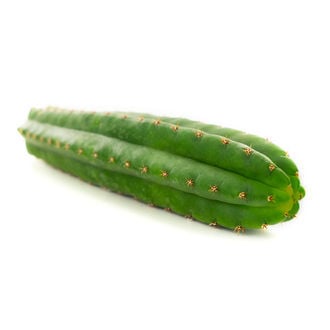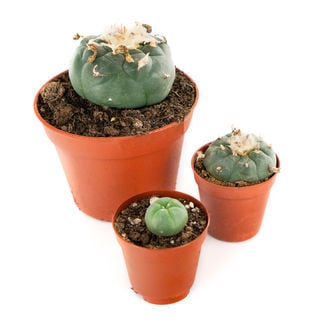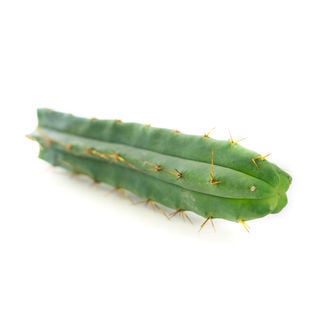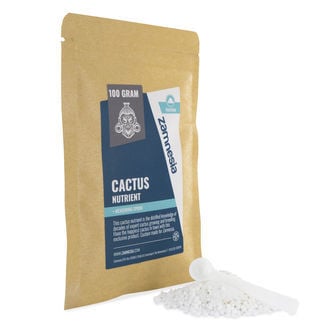San Pedro (Echinopsis pachanoi)
A.k.a. Trichocereus pachanoi. The San Pedro cactus (Echinopsis pachanoi) originates from Peru and Ecuador. This cactus contains the psychoactive compound mescaline and plays a very important part in Latin American shamanic culture. We sell cuttings in different sizes that will effortlessly resume their growth once they are put back in the ground.
| Buy 3 units | 5% Discount |
| Buy 5 units | 10% Discount |
| Buy 10 units | 15% Discount |
San Pedro (Echinopsis pachanoi): Previously known as 'Trichocereus pachanoi'
The San Pedro cactus (Echinopsis pachanoi) originates in the mountains of Peru and Ecuador where this mescaline cactus grows at an altitude of 2000-3000 meter. Nowadays this cactus can be found in other parts of the Andes, such as the Argentinean and Bolivian mountains. The San Pedro is a rapidly growing cactus: under the right circumstances, this cactus can grow up to 30 to 40 cm a year.
Cultivating the San Pedro cactus
Our cuttings of the San Pedro are exclusively derived from healthy and attractive cacti. These cuttings facilitate the home cultivation of your own San Pedro cactus. The cutting only needs to be placed in the ground after which the cutting will soon shoot roots and continue to grow, like it had never been out of the ground in the first place. Use special cactus soil and not the standard soil for indoor plants. This soil often contains an incorrect ratio of nutrients needed for cacti.
Water the cactus once a week in autumn and spring and only once every 2-3 weeks in winter. In summer you may water the cactus 3-5 times a week. The best method is to water the cactus from the bottom, so it is better to put the cactus in a pot with a punctured base. Place the pot in a shallow dish with water en the cactus will absorb what it needs. This method is preferred over watering the cactus with a spout from above.
Place the San Pedro cutting in the shade for the first month, allowing the cactus to adjust to its new surroundings and create a new root system. You will not need to water the cutting for the first 2-3 weeks.
Name change: From Trichocereus to Echinopsis
The Latin name for the San Pedro cactus has always been 'Trichocereus pachanoi', but recently a new classification for the cactus species was put in place. Now the San Pedro is subordinate to the much larger cacti family Echinopsis. The current and correct name for the San Pedro is therefore ‘Echinopsis pachanoi'. The name change has not yet caught on with the masses and the cactus is still commonly referred to as 'Trichocereus pachanoi'. It will probably take quite some time before people speak of the 'Echinopsis pachanoi'.
| Cactus | San Pedro |
|---|
More information related to this product:
🤩
J'ai eu le trip le plus incroyable de ma vie avec ce cactus !
Je compte bien planter le reste pour qu'il grandisse a nouveau
Está precioso y fuerte
Vino bien empaquetado. Crece muy bien y muy rápido. Lo tenemos en interior junto a un gran dlventanal y está perfecto. Ojalá nos acompañe décadas!
Growing well
Followed the instructions and the two cacti are now established and growing well
Kaktus
Všetko ok, kaktus prišiel rýchlo...kvalita odporúčam. Thanks zamnesia
Il va bien
Pepe se porte bien, malgré une installation un brin compliqué après deux trois tutos youtubes et un rempotage il s'est bien installé. J'ai bu un coup avec lui et il m'a dit qu'il avait un projet d'installation avec sa femme il m'a fait un peu peur par ce que je pensais qu'il allait devenir de droite en devenant propriétaire mais en vrai non ça va tranquille il m'a même invité à manger un molé un de ces jours et ça fait grave plaisir par ce qu'il vient de loin et malgré l'hiver il a bien pris racine ici donc chill
pinopinopino
Great. Arrived and happy.
San Pedro
Talea arrivata in ottime condizioni
Top!!!!
Ist super angewachsen
Tre belle talee
Tre belle talee arrivate in perfette condizioni, interrate da due settimane, prevedo ottimi risultati ;)
Good.
Very cool. Easy to grow. Been growing mine for a few years now. Too attached to them to skin them and harvest. Cut them and planted the cutting and multiplied it.
Please note: If your country is not on our approved shipping list, we’re unable to ship items to your region. For more information, check out the full list of approved locations here: Ordering & Shipping





 United States
United States




























